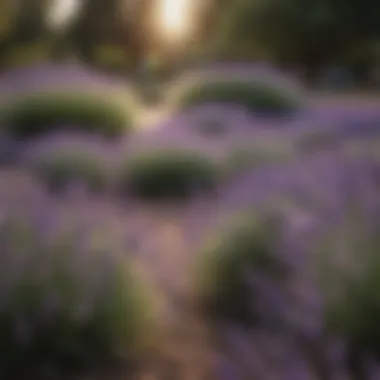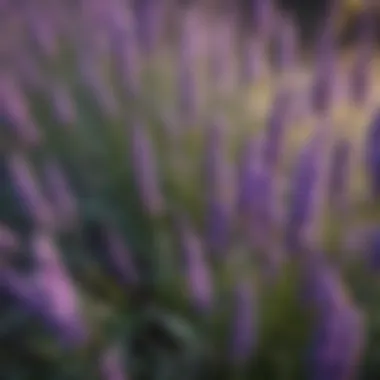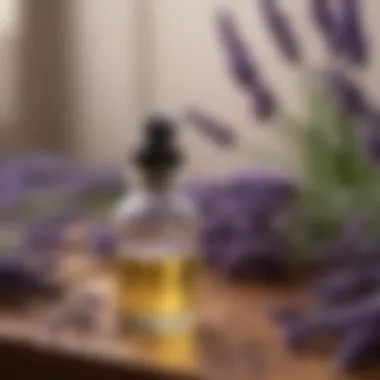Exploring Effective Lavenders for Mosquito Control


Intro
Lavender possesses a reputation that extends well beyond its aromatic allure. This fragrant herb is celebrated not only for its beautiful blooms and serene scent but also for its ability to repel unwanted insects, particularly mosquitoes. For homeowners and gardening enthusiasts, integrating lavender into landscapes is not merely about aesthetics; it is also an effective strategy for natural pest management. This article will explore various lavender species renowned for their mosquito-repelling properties, alongside practical cultivation tips and benefits of essential oils derived from this plant.
Design Inspiration
Current Trends in Landscape Design
In recent years, there has been a shift towards sustainable gardening practices, emphasizing the use of natural pest deterrents. Lavender gardens are emerging as both a design trend and an effective ecological solution. A lavender-infused garden can enhance outdoor spaces while providing an aromatic backdrop that is pleasing to the senses.
- Utilize lavender in borders and pathways for ornamental purposes.
- Combine lavender with other insect-repelling plants for a cohesive landscape.
Color Schemes and Palette Ideas
Lavender flowers provide a unique palette of purples, blues, and greens for outdoor aesthetics. When planning a garden, consider these color combinations:
- Pair lavender with white roses for a contrasting yet harmonious look.
- Integrate yellow marigolds to add warmth against the cooler lavender hues.
These combinations not only attract the eye but also create a welcoming environment, both for guests and beneficial insects.
Gardening Techniques
Plant Selection and Care
Selecting the right variety of lavender is crucial to ensuring its effectiveness as a mosquito repellent. Among the top contenders are English Lavender (Lavandula angustifolia), known for its strong scent, and French Lavender (Lavandula dentata), which has unique foliage.
Here are some care tips:
- Ensure well-draining soil to prevent root rot.
- Water regularly but avoid over-saturation.
- Prune lavender after blooming to encourage new growth.
Such practices can enhance the growth potential of these plants.
Indoor vs. Outdoor Gardening
While lavender thrives in outdoor environments, it is also possible to grow these plants indoors with the right conditions. Indoor lavender gardening ensures a year-round supply of this useful herb, providing immediate access for culinary and aromatic purposes.
- For outdoor gardens, place lavender in full sun and protect it from strong winds.
- Indoors, select pots with drainage and provide stable sunlight exposure.
"A well-kept lavender plant not only serves as a delightful addition to any garden but stands as a potent barrier against mosquitoes."
By understanding cultivation methods and leveraging the natural pest-repelling properties of lavender, homeowners can create environments that are both beautiful and functional.
Intro to Lavender and Mosquito Repellency
The use of lavender in repelling mosquitoes stands as a compelling intersection of nature and practicality. This article aims to shed light on why lavender is increasingly regarded as a viable option for those looking to enhance their outdoor spaces while also addressing the perennial issue of mosquito control. The natural properties of lavender not only create an inviting ambiance in gardens but also serve a functional purpose.
Understanding the Relationship
Lavender, known scientifically as Lavandula, includes several species and varieties appreciated for their fragrant blooms and aromatic oils. The relevance of lavender extends beyond aesthetics; it has been noted for its insect-repelling capabilities. This aspect makes it particularly attractive for homeowners who seek eco-friendly solutions.
Research indicates that certain compounds found in lavender exhibit insect-repelling properties. For instance, linalool and linalyl acetate, dominant in many lavender species, emit scents that are unpleasant to mosquitoes. This understanding forms the basis for using lavender as an effective deterrent.
Historical Usage of Lavender as Deterrent


The historical context for using lavender as a deterrent dates back centuries. Historically, lavender was commonly utilized in folk medicine and as a fragrance for bathing. More importantly, its application as an insect repellent has roots in ancient practices. In various cultures, lavender was hung in doorways and windows, intended to keep insects at bay, including mosquitoes.
This time-honored approach underscores a longstanding recognition of lavender's benefits. In modern contexts, this historical reliance is being revisited as people seek to complement their lifestyles with natural pest control methods.
In light of these points, the discussion surrounding lavender and mosquito repellency is both timely and significant. The knowledge of how lavender functions as a deterrent beckons a closer exploration of specific varieties that are effective, their cultivation, and practical usage in everyday life.
Top Lavender Varieties That Repel Mosquitoes
Identifying the right lavender variety serves as the foundation for effective mosquito repellency. Each species exhibits distinct characteristics that influence its efficacy as a natural deterrent. Homeowners and gardening enthusiasts should consider the unique traits of each variety. Understanding these traits is crucial not only for choosing the right plants but also for ensuring optimal growing conditions and maximum mosquito-repelling effects.
Lavandula angustifolia
Lavandula angustifolia, commonly known as English lavender, is perhaps the most regarded species when it comes to mosquito repelling qualities. Its strong scent, rich in linalool and linalyl acetate, is a natural deterrent for mosquitoes. Not only does this variety thrive in well-drained soil, but it also offers a compact growth habit, making it suitable for small gardens or container planting. The purple flowering spikes are not only visually appealing but also attract beneficial pollinators, adding ecological value to any garden.
Lavandula intermedia
Lavandula intermedia, often referred to as lavandin, holds notable mosquito-repelling properties. This hybrid variety is a cross between Lavandula angustifolia and Lavandula latifolia. It is known for its increased oil yield compared to its parents. As a result, it provides enhanced mosquito repellency. Lavandula intermedia generally grows taller, making it a striking choice for borders and hedging. It thrives well in similar conditions as its counterparts, needing full sun and slightly alkaline soil to flourish.
Lavandula stoechas
Lavandula stoechas, or Spanish lavender, is another effective variety in the battle against mosquitoes due to its unique aroma and chemical composition. This species features distinctive flower heads that resemble pine cones and are often adorned with showy bracts. It grows well in hotter, drier climates, providing an excellent option for areas with less humidity. The oil extracted from Lavandula stoechas has a slightly different composition than that from other varieties, contributing to its mosquito-repelling qualities.
Lavandula x angustifolia 'Hidcote'
Lavandula x angustifolia 'Hidcote' is a popular cultivar that combines the best aspects of its parent species. Renowned for its compact size and dense flower spikes, this variety provides significant aesthetic value as well as functionality in mosquito control. It is well-suited for small gardens and containers, making it highly accessible for homeowners. The deep purple blooms not only attract pollinators but also tend to repel various insects, making it a versatile addition to any landscape.
How Lavender Works to Repel Mosquitoes
Understanding how lavender contributes to mosquito control is crucial for cultivating its benefits in home gardens. Lavender is not only appealing for its aesthetic qualities but also for its effectiveness as a natural deterrent against mosquitoes. This section will delve into the specific chemical compounds found in lavender and explain their mechanism of action against these pests, providing insights that can enhance the gardening experience for homeowners.
Chemical Compounds in Lavender
Lavender contains various chemical compounds that play a fundamental role in its ability to repel mosquitoes. Among these compounds, linalool and linalyl acetate are particularly significant. These constituents are responsible for the distinct fragrance of lavender and have been found to exhibit insect-repellent properties. Research indicates that linalool is effective not just against mosquitoes but also against other insects, making it a versatile compound in pest management.
Other compounds such as camphor and 1,8-cineole also contribute to the repelling effect. These substances can disrupt mosquito sensory mechanisms, interfering with their ability to locate hosts for feeding. In summary, the unique combination of chemicals in lavender creates an unfavorable environment for mosquitoes while being relatively safe for humans and pets.
Mechanism of Action Against Mosquitoes
The mechanism of action by which lavender repels mosquitoes primarily involves olfactory sensitivity. Mosquitoes are reliant on their sense of smell to detect carbon dioxide and body heat emitted by potential hosts. The strong scent of lavender masks these cues, confusing mosquitoes and reducing their ability to locate individuals.
Additionally, the compounds in lavender can act as toxins to developing larvae when applied in specific forms. This dual action—repelling adult mosquitoes while potentially harming larvae—positions lavender as a powerful ally in integrated pest management.
In practice, the effectiveness of lavender in repelling mosquitoes can depend on several factors, including the concentration of its essential oils and the method of application. Using lavender essential oil mixed with a carrier oil can amplify its repelling effects when applied to the skin or in the vicinity of outdoor gatherings.
"Using lavender not only enhances one's garden aesthetics but also serves a practical purpose in maintaining comfort during outdoor activities."
Overall, the scientific foundation of how lavender operates as a mosquito repellent makes it a noteworthy addition to any garden. Implementing these natural tactics can provide sustainable solutions to mosquito problems, appealing to environmentally conscious homeowners seeking effective alternatives.
Cultivation of Mosquito-Repelling Lavenders
Cultivating lavender that repels mosquitoes is important not only for achieving a natural pest deterrent but also for enhancing the overall appeal of your outdoor spaces. The integration of lavender into gardens contributes to biodiversity and offers various benefits. It creates a barrier against not only mosquitoes but other pests. Understanding how to effectively cultivate these plants can lead to thriving gardens that serve multiple purposes.
Optimal Growing Conditions


Lavenders thrive in conditions that mimic their native habitats, which are typically sunny and dry. They need plenty of sunlight, ideally six to eight hours a day, to produce their essential oils. In terms of soil, the drainage is crucial. A sandy or well-drained soil type enhances growth and prevents rot. Here are some key conditions for growing lavenders:
- Sunlight: Full sun is necessary for optimal development.
- Soil Type: Well-drained sandy or loamy soils are best.
- pH Level: Lavender prefers alkaline soils with a pH of 6.5 to 7.5.
- Irrigation: Drought-tolerant, lavenders need careful watering; overwatering can damage the roots.
These elements create a nurturing environment that allows lavender plants to reach their potential, producing oils that fend off mosquitoes effectively.
Planting Techniques
When it comes to planting lavender, proper techniques can lead to higher success rates. Start by selecting healthy plants, whether seeds or young plants. If starting from seeds, germination should be in late winter or early spring. Transplant young plants outside once the risk of frost has passed. Here are some useful techniques:
- Spacing: Ensure ample spacing (about 18 to 24 inches apart) for air circulation.
- Depth: Plant seedlings at the same depth as in their nursery containers.
- Mulching: Apply a light layer of mulch to conserve moisture but ensure it does not touch the stems.
- Watering Immediately: Water plants well after planting and provide ongoing, but moderate, care as they establish.
Using these methods can enhance the production of oil in the leaves which contributes to their mosquito-repelling properties.
Maintenance and Care Tips
Once established, lavender requires some maintenance to stay healthy. Regular care practices will keep plants thriving and able to deter mosquitoes effectively. The following tips are essential for maintaining a lavender garden:
- Pruning: Early spring is a good time for pruning, which encourages bushier growth and prevents woody stems.
- Fertilizing: Avoid heavy fertilizers; a light application of balanced fertilizer in spring can help.
- Pest Management: Keep an eye out for pests like aphids. Organic sprays can manage infestations.
- Water Management: Water infrequently, allowing soil to dry out between watering sessions.
Through careful attention to these practices, lavender plants can flourish and ensure their potent oils remain at effective levels against mosquitoes.
"The cultivation of mosquito-repelling lavenders is not only a solution for pest control but a step toward creating sustainable gardens that support ecosystems."
By focusing on the cultivation techniques outlined above, homeowners can create effective, beautiful spaces filled with lavender that serves both aesthetic and functional purposes.
Using Lavender Essential Oil for Mosquito Control
Lavender essential oil is a notable natural repellent for mosquitoes. Its popularity comes from the combination of effective properties and pleasant fragrance. Using lavender oil can be a crucial aspect for homeowners seeking eco-friendly solutions to mosquito problems. The oil derived from lavender plants contains compounds that deter mosquitoes and can be a gentle alternative to chemical repellents.
Extraction Methods
The process of extracting lavender oil is vital for maintaining its effectiveness. Several methods exist:
- Steam Distillation: This is the most common method. Steam passes through lavender flowers, causing the essential oil to vaporize. The vapor is then cooled and collected, yielding pure lavender oil.
- Cold Pressing: Less common for lavender, this method extracts oil from the plant’s rind without heat. It preserves the natural scent and compounds well, though it is primarily used for citrus.
- Solvent Extraction: In cases where chemical solvents are used, the resulting oil often contains more impurities. While this method is effective, it may not result in the highest quality oil.
Regardless of the method, ensure that the lavender oil comes from reputable sources to avoid inferior products.
Application Techniques
Applying lavender oil for mosquito control can be done in several ways:
- Diffusion: Using an essential oil diffuser allows the aroma to spread throughout an area, creating a barrier against mosquitoes.
- Topical Application: Diluting lavender essential oil with carrier oils such as coconut or jojoba oil makes it safe for skin application. This personal repellent can be applied directly to exposed skin during outdoor activities.
- Sprays: Mixing lavender oil with water in a spray bottle provides a quick solution. Spraying around doorways, windows, and outdoor spaces creates an effective deterrent.
"Essential oils like lavender are not just fragrant but serve as effective natural guards against pests."
Safety Considerations
Despite its natural origins, safety is important when using lavender oil. Consider the following points:
- Skin Sensitivity: Always conduct a patch test before applying oil to larger areas of skin. Some people may be sensitive or allergic to lavender oil.
- Dilution: Always dilute essential oils with carrier oils before skin contact. Applying undiluted oil can cause irritation.
- Inhalation: When diffusing lavender oil, ensure good ventilation. Overly concentrated air may lead to headaches or respiratory discomfort for sensitive individuals.
In summary, the careful use of lavender essential oil can enhance your strategy for mosquito control. By understanding extraction, application, and safety, homeowners can effectively integrate this natural solution into their pest management efforts.


Integrating Lavender into Your Landscape
Integrating lavender into your landscape serves various purposes. Beyond its mosquito-repelling qualities, lavender offers aesthetic appeal and creates a pleasant aroma. Homeowners can architecturally enhance their outdoor space while reaping the benefits of natural pest control. Lavender plants can fit into different garden types, whether traditional, modern, or cottage-style gardens. Additionally, their vibrant purple flowers can attract beneficial insects like bees. This interaction promotes a healthier ecosystem.
Design Ideas for Lavender Gardens
Designing a lavender garden requires consideration of spatial arrangement and plant selection. Utilize the following ideas to create a harmonious space:
- Color Harmony: Pair lavender with plants that have complementary colors, such as white daisies or yellow marigolds. The contrast can enhance the visual appeal.
- Height Variation: Use lavender varieties of different heights to create vertical interest. Taller species can be positioned at the back or center of the garden.
- Pathways: Create meandering paths lined with lavender to encourage exploration. This design adds an inviting element to the garden.
- Borders and Edging: Plant lavender along pathways and garden borders. This not only adds decoration but also serves as a deterrent for unwanted pests.
- Grouped Planting: Group lavender in clusters to form a more dramatic impact. Grouping also helps with pollination.
Companion Planting with Lavender
Companion planting is a practice that increases the growth and health of plants through strategic placement. Lavender can be paired successfully with several other plants:
- Rosemary: Similar growing conditions make rosemary an excellent companion. Both enjoy full sun and well-drained soil.
- Thyme: This low-growing herb thrives in similar environments. It adds to the ground cover and helps retain soil moisture.
- Sage: The aroma of sage may enhance the scent profile of your garden, while also benefiting from the same care as lavender.
- Vegetables: Planting lavender near vegetables like carrots and cabbage can help repel pests that target these crops.
Companion planting not only maximizes space but also contributes to a balanced garden environment.
Incorporating lavender into your landscape is more than just an aesthetic choice. It creates a functionally beautiful space that can help control mosquito populations, enhance biodiversity, and offer a sensory experience that enriches the garden's atmosphere.
Sustainability of Using Lavender for Mosquito Control
Sustainability in pest control is an increasingly important topic for homeowners and gardeners alike. As people become more aware of environmental issues, the demand for natural and sustainable mosquito repellents continues to grow. Lavender offers a formidable solution not only for its efficiency in repelling mosquitoes but also for its minimal environmental impact. When utilizing lavender for mosquito control, one can enjoy both a beautiful garden and a safer outdoor experience without resorting to harmful chemicals.
Benefits of Natural Repellents
Natural repellents, such as lavender, come with several benefits. First and foremost is the health aspect. Unlike chemical repellents, which may contain toxic substances, lavender is generally safe for humans and pets. This is a significant advantage for families with children or pets that might be exposed to conventional sprays.
Moreover, lavender possesses a pleasant fragrance that many find soothing and appealing. This feature makes it a favored choice for gardens and outdoor spaces. By planting lavender, individuals can create an inviting atmosphere without the overwhelming scent of synthetic repellents.
Lavender's ability to repel mosquitoes derives from its unique chemical compounds. These compounds work effectively to mask the scent that attracts mosquitoes, creating a barrier that discourages them from entering the vicinity. This natural approach is not just effective but also promotes a healthier lifestyle by reducing exposure to chemical agents.
Impact on Local Ecosystems
The use of lavender in gardens extends beyond mere aesthetics. Its integration into local ecosystems can provide substantial benefits. For starters, lavender is known to attract beneficial insects such as bees and butterflies. This characteristic is crucial for pollination and supports the health of gardens and surrounding flora.
Additionally, the cultivation of lavender contributes positively to soil health. It is a drought-resistant plant that requires less water once established, which is beneficial in regions facing water scarcity. This resilience supports sustainable gardening practices and helps conserve resources.
"Natural repellents like lavender not only help in controlling pests but also support healthy ecosystems."
In summary, integrating lavender into mosquito control strategies promotes sustainability by offering a safe alternative to chemical products. The benefits extend to individual health, local ecosystems, and resource conservation, making lavender a well-rounded choice for effective mosquito management. As homeowners and gardeners look for more sustainable solutions, the inclusion of lavender in their landscapes becomes an intelligent decision.
Ending: The Future of Mosquito Control
As we shift towards more sustainable living, it is becoming increasingly clear that integrating natural methods into pest control strategies is essential. Mosquito control is no exception. The use of lavender, with its proven properties to repel these insects, presents an effective and environmentally friendly approach to managing mosquito populations.
Lavender as Part of an Integrated Approach
Lavender should not be seen as a standalone solution but rather as part of a broader integrated pest management strategy. This involves combining various methods to minimize mosquito populations while respecting ecological balance. By planting lavender alongside other pest-repelling plants, homeowners can create a diversified garden that not only deters mosquitoes but also attracts beneficial insects. This holistic approach can enhance garden resilience and sustainability.
A few tips to integrate lavender include:
- Selection of Companion Plants: Combine lavender with plants like marigolds and basil that also contribute to pest control.
- Use of Essential Oils: Incorporate lavender essential oil in sprays, diffusers, or candles, working alongside other natural repellents.
- Regular Maintenance Practices: Regularly prune and maintain not only lavender but other plants for best growth and pest deterrence.
Exploring Additional Natural Options
While lavender is a fantastic choice for repelling mosquitoes, it is valuable to consider other natural solutions that complement its benefits. Botanical insect repellents have gained popularity amongst environmentally conscious consumers. For instance, citronella grass and neem oil are known for their repelling properties as well.
Further options might include:
- Plants That Repel Mosquitoes: Other varieties like catnip and peppermint can also deter mosquitoes, enhancing the array of deterrents in your garden.
- Essential Oils: Different oils such as eucalyptus and tea tree oil can be employed along with lavender for increased effectiveness.
- Physical Barriers: Encourage solutions like using mosquito nets, screen doors, and window screens to physically keep mosquitoes at bay.
Combining these strategies not only increases the effectiveness of pest control but encourages a healthier outdoor environment for all living beings. An integrated approach that incorporates various natural methods will pave the way for more sustainable and effective mosquito control strategies, making spaces more enjoyable for homeowners and garden enthusiasts alike.



